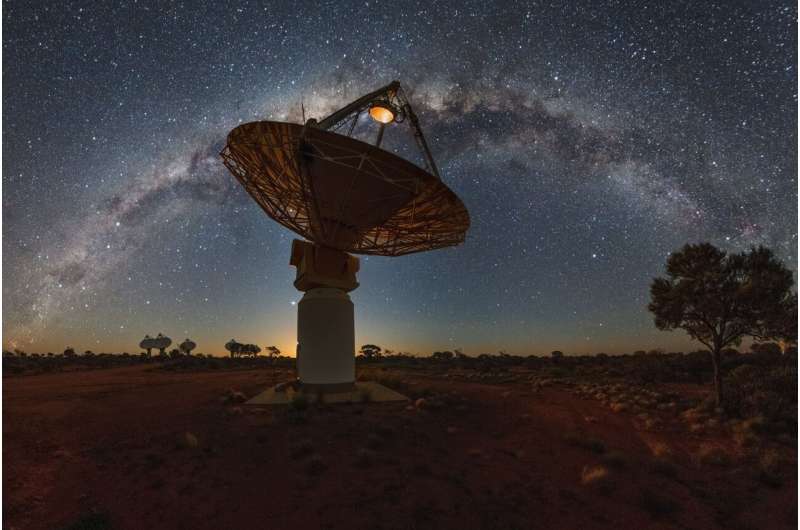This article has been reviewed according to Science X's editorial process and policies. Editors have highlighted the following attributes while ensuring the content's credibility:
fact-checked
peer-reviewed publication
trusted source
proofread
New research offers insight into fast radio bursts

Researchers using a telescope owned and operated by CSIRO, Australia's national science agency, have detected a "fast radio burst" in a nearby galaxy that questions what we know about how the phenomena form.
New results published today in The Astrophysical Journal indicate the source of the interstellar blast is in a much calmer galactic environment than other known events.
Marcin Glowacki from the Curtin University node of the International Center for Radio Astronomy Research (ICRAR) led the latest research using CSIRO's ASKAP radio telescope on Wajarri Yamaji Country in Western Australia.
Dr. Glowacki said while previous studies suggest colliding galaxies could create massive stars that may eventually cause fast radio bursts, this paper's findings challenge that idea.
"Of the radio bursts where we've studied their host galaxies in detail, we've seen colliding and merging galaxies. In this research, we aren't seeing those same clear signals of a turbulent galaxy," Dr. Glowacki said.
"What we've seen in this new paper is that the host galaxy itself appears undisturbed, quiet even. This suggests that either a massive star that caused the fast radio burst was born another way, or that this powerful burst was created by something else entirely," he said.
Co-author Dr. Karen Lee-Waddell, Director of the Australian SKA Regional Center and the Project Scientist of WALLABY, said astronomers can so far study the "host" galaxy for only a few fast radio bursts and this new discovery highlights the importance of finding many more.
"Research like this is necessary for studying the environments around the mysterious radio bursts, as galaxies are made up of more than just stars.
"We are keen to study fast radio bursts and their host galaxies in great detail, not just to solve an intergalactic mystery but because they can tell us more about the structure and evolution of galaxy systems," she said.
Two teams of researchers are using ASKAP's unique capabilities to investigate these enigmatic events and their host galaxies simultaneously.
Key to this ongoing research is the telescope's unique ability to analyze the gas distribution in galaxies, including hunting for the signatures that could help astronomers better understand the cosmic flashes.
Dr. George Heald, Science Program Director for CSIRO's Australia Telescope National Facility, said ASKAP's greatest strength is its ability to quickly survey a large area of sky.
"Each of ASKAP's 36 dish antennas is equipped with a specialized receiver that radio astronomers can steer to efficiently map the sky," Dr. Heald said.
"This helps researchers produce some of the best radio astronomy data in the world, to better understand the universe," he said.
Fast radio bursts were discovered in 2007 using CSIRO's Parkes radio telescope, Murriyang. The intense, momentary flashes release as much energy in a few milliseconds as our sun in 80 years.
More information: M. Glowacki et al, WALLABY Pilot Survey: H i in the Host Galaxy of a Fast Radio Burst, The Astrophysical Journal (2023). DOI: 10.3847/1538-4357/acc1e3
Journal information: Astrophysical Journal
Provided by CSIRO




















